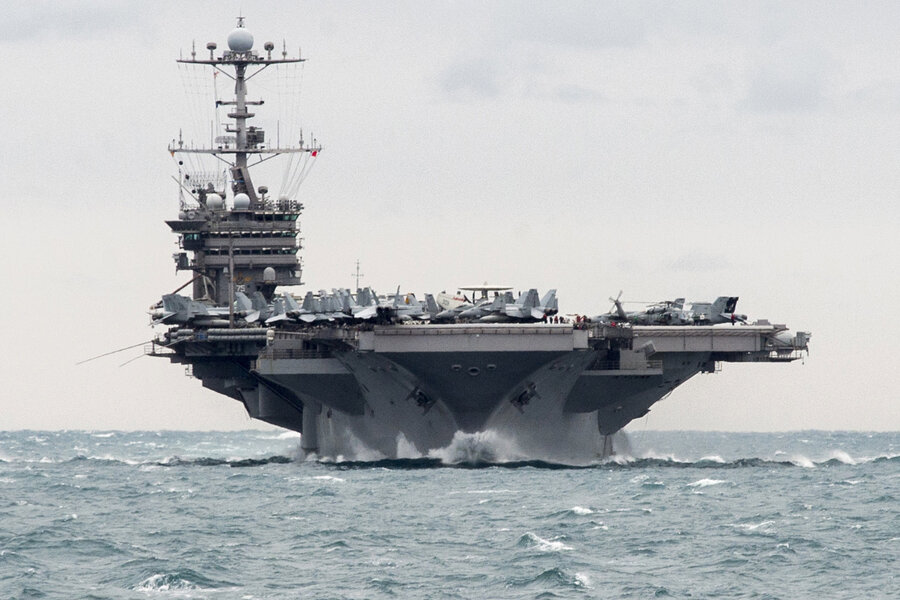US says Iran launched 'provocative' rocket test near ships
Loading...
| Dubai, United Arab Emirates
The US on Wednesday accused Iran of launching a "highly provocative" rocket test last week near its warships and commercial traffic passing through the Strait of Hormuz, exposing how tensions between the two countries could escalate even after a landmark nuclear deal.
The strategic Persian Gulf waterway, which sees nearly a third of all oil traded by sea pass through it, has been the scene of past confrontations between America and Iran, including a one-day naval battle in 1988.
But Saturday's incident brought no immediate response from Iranian officials or media, while French authorities downplayed its danger.
Military vessels taking part in the war against the Islamic State group in Iraq and Syria also pass through the narrow waterway between Iran and Oman. On Saturday, the USS Harry S. Truman aircraft carrier, the USS Bulkeley destroyer and a French frigate, the FS Provence, were passing through it, said Cmdr. Kyle Raines, a US Central Command spokesman.
As they passed, Iranian Revolutionary Guard vessels, hailing other ships in the strait over maritime radio, announced they'd be carrying out a live fire exercise, Raines said in a statement. After 23 minutes, the Iranian boats fired "several unguided rockets" 1,500 yards from the warships and commercial traffic, he said.
While the rockets weren't fired in the direction of any ships, Raines said Iran's "actions were highly provocative."
"Firing weapons so close to passing coalition ships and commercial traffic within an internationally recognized maritime traffic lane is unsafe, unprofessional and inconsistent with international maritime law," he said.
A French military official, speaking to The Associated Press on condition of anonymity as he was not authorized to be publicly named, confirmed the rocket fire took place Saturday. However, the official said the French military did not consider it to be a threatening event as the rocket fire clearly wasn't directed toward the Western fleet.
The French frigate is now escorting the French aircraft carrier Charles de Gaulle, which is launching airstrikes against the Islamic State group, the official said.
NBC News first reported news of the Iranian rocket fire.
The Strait of Hormuz is only 21 miles wide at its narrowest point. Ships traversing the chokepoint have even less room to maneuver. The shipping lane in either direction is only 2 miles wide, with a 2-mile buffer zone between them.
The U.S. Navy's 5th Fleet is based in nearby Bahrain, on the southern coast of the Gulf. It conducts anti-piracy patrols in the greater Gulf and serves as a regional counterbalance to Iran.
US and Iranian forces clashed in the Strait of Hormuz in the 1980s, during the Iran-Iraq war. On April 18, 1988, the US attacked two Iranian oil rigs and sank or damaged six Iranian vessels, including two naval frigates, in Operation Praying Mantis. That came after the near-sinking of the missile frigate USS Samuel B. Roberts by an Iranian mine.
A few months later, in July 1988, the USS Vincennes in the strait mistook an Iran Air flight heading to Dubai for an attacking fighter jet, shooting down the plane and killing all 290 passengers and crew onboard. The shoot-down of the jet came shortly after the US vessel reported coming under fire from Iranian speedboats.
Tensions have persisted in the strait even into this year. Iran sank a replica of a US aircraft carrier in February near the strait and it earlier tested out so-called "suicide drones" it said could crash into naval vessels.
Iran seized a Marshall Islands-flagged cargo ship and later released it in May after its forces had earlier surrounded a US-flagged cargo ship transiting the strait. That caused the 5th Fleet to escort commercial ships traveling in the Gulf for a short time.
Iran and world powers led by the US agreed to a landmark nuclear deal earlier this year to limit Tehran's enrichment of uranium in exchange for lifting economic sanctions. Iran has always denied seeking nuclear arms.
The deal reached with moderate President Hassan Rouhani's administration has been panned by Iranian hard-liners, and in the months since, Iran has conducted missile tests criticized by the US, as well as aired footage on state television of an underground missile base.
Saturday's rocket fire should be seen as part of a pattern by Iran since its naval loss in 1988, said Eugene Gholz, an associate professor at the University of Texas who is an expert on the use of military power in the Strait of Hormuz. Iran wants to portray itself as the region's major power, but doesn't want to directly battle US naval forces again, he said.
"Theater is a good word for it," Gholz said. "You build a set, you carry out activity on the set, you send actors — in this case (Iranian Revolutionary Guard) special forces — and you hope people are watching and really paying the price of admission."







